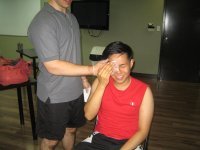
Syringoma usually occurs in young adults and it is characterized by the occurrence of a non-cancerous bump on the upper cheeks and lower eyelids of affected person. It happens due to the overgrowth of cells of the sweat glands but, it is completely harmless.
Who’s At Risk?
Syringoma can occur to any people irrespective of age, sex and ethnicity. However, it is seen that in most cases it occur to individuals after puberty and females are known to be more affected by it then men. Sometimes, syringoma run in families. Also, statistics shows that about 18% people who have Down syndrome also have syringoma. Individuals suffering from diabetes mellitus are likely to suffer from a kind of syringoma called clear cell syringoma. Another kind of syringoma called eruptive syringoma is more seen in people having darkened skin.
Signs and Symptoms:
The syringoma bumps are harmless. They do no itch or cause any pain. The most common location for the occurrence of syringoma are listed below:
- Upper cheeks
- Lower eyelids
- Armpits
- Chest
- Abdomen
- Forehead
- Genitalia (penis or vulva)
Syringomas lesions generally occur as tiny (1–3 mm) flesh-colored-to-yellowish bumps on the body. They occur in clusters and appear on both side of the body in a symmetrical fashion.
In eruptive syringoma, multiple lesions develop in the body at the same time. They typically occur on the chest and abdomen.
Self-Care Guidelines:
If you notice any new skin growth on your body, you should consult your doctor and get a correct diagnosis done. If the new skin growth is syringoma, there is nothing to worry about. However, you might choose to get it removed from the body by a dermatologist if it looks cosmetically unappealing.
To diagnose any new skin growth correctly, your doctor follow a procedure. It is as follows:
- Firstly they will numb the skin with an injectable anesthetic.
- Then using a scalpel or a surgical blade they will scoop out a small piece of flesh. The skin is then stitched and treated with an antiseptic solution. It will heal in a week or two.
- The sample skin is then examined under a microscope by a dermapathologist. If it is ascertained that it is syringoma, then usually no treatment is required as the condition is benign. But, it you want you can get it removed surgically.
There is a risk of scarring if you opt to get them removed surgically. Otherwise the process is fairly simple. You can get them removed by the following processes:
- Get the bumps or lesions burnt or electro-cauterized with an electric needle.
- Excision of the bumps with a scalpel, surgical scissors, or flexible razor blade
- Get carbon dioxide laser treatment on the bumps
- Opt for dermabrasion through which the lesions are eventually rubbed out.
- Get them treated with cryosurgery. In this process liquid nitrogen is used to do away with the lesions.
